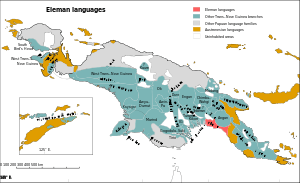Eleman languages
| Eleman | |
|---|---|
| Geographic distribution: | New Guinea |
| Linguistic classification: |
|
| Subdivisions: |
|
| Glottolog: | nucl1580 (Eleman proper)[1] |
|
Map: The Eleman languages of New Guinea
The Eleman languages
Other Trans–New Guinea languages
Other Papuan languages
Austronesian languages
Uninhabited | |
The Eleman languages are a family of Papua New Guinea.
Languages and classification
The five languages of Eleman proper are clearly related. They were identified as a family by Sidney Herbert Ray in 1907, and would later be incorporated in the Trans–New Guinea classifications of Stephen Wurm (1975) and of Malcolm Ross (2005).
Purari was included by Brown (1968), but the only evidence is the 1sg pronoun nai, which might simply be a reflection of TNG *na.
The purported evidence for including Eleman in the Trans–New Guinea family lies in Kaki Ae. Franklin (1995) shows regular sound correspondences between Kaki Ae and Eleman, including Kaki Ae n to Eleman *r, so Kaki Ae nao 1sg appears to be cognate with Eleman *ara, both perhaps descending from proto-TNG *na. Likewise, Kaki Ae nu'u may reflect pTNG *nu, and the forms of the 2sg pronouns, ao and *a, are common in TNG languages. Ross states that the Kaki Ae isolate links Eleman proper within TNG. However, Glottolog notes that the sound correspondences are just what would expect from loans, given the different phonologies of the languages: Eleman has no n/l/r distinction, and Kaki Ae has no t/k distinction.[2]
The pronouns are as follows:
Eleman proper sg pl 1 *ara *ela 2 *a *e(u) 3 *are *ere(u) Kaki Ae sg pl 1 nao nu'u 2 ao ofe 3 era era-he
References
- ↑ Hammarström, Harald; Forkel, Robert; Haspelmath, Martin; Bank, Sebastian, eds. (2016). "Eleman proper". Glottolog 2.7. Jena: Max Planck Institute for the Science of Human History.
- ↑ Hammarström, Harald; Forkel, Robert; Haspelmath, Martin; Bank, Sebastian, eds. (2016). "Kaki Ae". Glottolog 2.7. Jena: Max Planck Institute for the Science of Human History.
- Ross, Malcolm (2005). "Pronouns as a preliminary diagnostic for grouping Papuan languages". In Andrew Pawley; Robert Attenborough; Robin Hide; Jack Golson. Papuan pasts: cultural, linguistic and biological histories of Papuan-speaking peoples. Canberra: Pacific Linguistics. pp. 15–66. ISBN 0858835622. OCLC 67292782.
